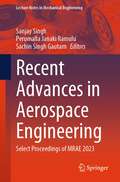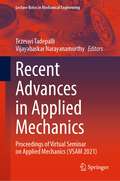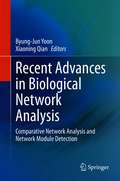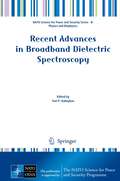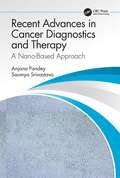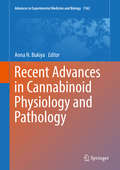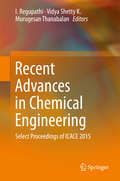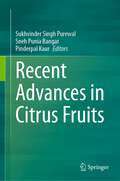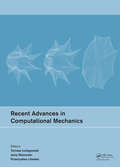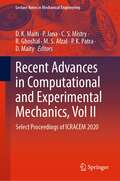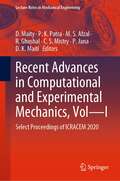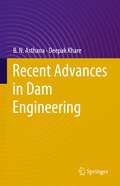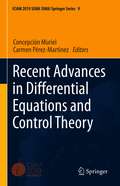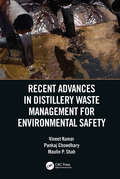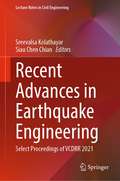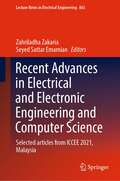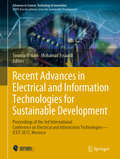- Table View
- List View
Recent Advances in Aerospace Engineering: Select Proceedings of MRAE 2023 (Lecture Notes in Mechanical Engineering)
by Sanjay Singh Sachin Singh Gautam Perumalla Janaki RamuluThe book presents the select proceedings of 2nd International Conference on Modern Research in Aerospace Engineering (MRAE 2023). It covers the latest research in the field of aerospace engineering and space technology. Various topics covered in this book are aerospace propulsion; space research; avionics and instrumentation; aerodynamics, wind tunnel and computational fluid dynamics; structural analysis and finite element method; aerospace materials and manufacturing system; air safety and airworthiness; aircraft control system and stability; aircraft maintenance, overhauling, NDT and other technical tests; autonomous airborne systems; airborne defence systems; AI and ML applications in aerospace engineering; unmanned aerial vehicles and flight mechanics. The book will be useful for researchers and professionals in aerospace engineering and space science and technology.
Recent Advances in Animal Nutrition and Metabolism (Advances in Experimental Medicine and Biology #1354)
by Guoyao WuThis book covers hot topics in the nutrition and metabolism of terrestrial and aquatic animals, including the interorgan transport and utilization of water, minerals, amino acids, glucose, and fructose; the development of alternatives to in-feed antibiotics for animals (e.g., swine and poultry); and metabolic disorders (or diseases) resulting from nutrient deficiencies. It enables readers to understand the crucial roles of nutrients in the nutrition, growth, development, and health of animals. Such knowledge has important implications for humans. Readers will also learn from well-written chapters about the use of new genome-editing biotechnologies to generate animals (e.g., cows and swine) as bioreactors that can produce large amounts of pharmaceutical proteins and other molecules to improve the health and well-being of humans and other animals, as well as the growth and productivity of farm animals. Furthermore, the book provides useful information on the use of animals (e.g., cattle, swine, sheep, chickens, and fish) as models in biomedical research to prevent and treat human diseases, develop infant formulas, and improve the cardiovascular and metabolic health of offspring with prenatal growth restriction. Editor of this book is an internationally recognized expert in nutrition and metabolisms. He has about 40 years of experience with research and teaching at world-class universities in the subject matters. He has published more than 660 papers in peer-reviewed journals, 90 chapters in books, and authored two text/reference books, with a very high H-index of 127 and more than 66,000 citations in Google Scholar. This publication is a useful reference for nutrition and biomedical professionals, as well as undergraduate and graduate students in animal science, aquaculture, zoology, wildlife, veterinary medicine, biology, biochemistry, food science, nutrition, pharmacology, physiology, toxicology, and other related disciplines. In addition, all chapters provide general and specific references to nutrition and metabolism for researchers and practitioners in animal agriculture (including aquaculture), dietitians, animal and human medicines, and for government policy makers.
Recent Advances in Applied Mathematics and Applications to the Dynamics of Fluid Flows: 5th International Conference on Applications of Fluid Dynamics (ICAFD) 2020 (Lecture Notes in Mechanical Engineering)
by J. Prakash Suripeddi Srinivas Badeti SatyanarayanaThis book presents select proceedings of the 5th International Conference on Applications of Fluid Dynamics (ICAFD 2020) organized by the School of Mechanical Engineering Science, VIT-AP University, India, in association with the University of Johannesburg, Auckland Park Kingsway Campus, South Africa. It identifies the existing challenges in the area of applied mathematics and mechanics (of solids and fluids) and emphasizes the importance of establishing new methods and algorithms to address these challenges. The topics covered include diverse applications of fluid dynamics in aerospace dynamics and propulsion, atmospheric sciences, compressible flow, environmental fluid dynamics, control structures, viscoelasticity and mechanics of composites. Given the contents, the book will be a useful resource for researchers as well as practitioners working in the area of mechanical engineering and applied mathematics.
Recent Advances in Applied Mechanics: Proceedings of Virtual Seminar on Applied Mechanics (VSAM 2021) (Lecture Notes in Mechanical Engineering)
by Tezeswi Tadepalli Vijayabaskar NarayanamurthyThis book comprises the proceedings of the Virtual Seminar on Applied Mechanics 2021 organized by the Indian Society for Applied Mechanics. The contents of this volume focus on solid mechanics, fluid mechanics, biomechanics/biomedical engineering, materials science and design engineering. The authors are experienced practitioners and the chapters encompass up-to-date research in the field of applied mechanics. This book will appeal to researchers and scholars across the broad spectrum of engineering involving the application of mechanics in civil, mechanical, aerospace, automobile, bio-medical, material science, and more.
Recent Advances in Bio-Energy Research: Select Proceedings of the 3rd International Conference, ICRABR 2022 (Springer Proceedings in Energy)
by Sachin Kumar Nikhil Gakkhar Anil K. Sarma Neal T. GrahamThis book comprises select proceedings of the 3rd International Conference on Recent Advances in Bio-energy Research (ICRABR 2022), providing comprehensive coverage on bio-energy-related fields and prospects of bio-energy in terms of waste management for energy generation, storage, and application. The content includes themes such as optimisation of energy systems, recent advances in biofuels and bioenergy, biomass hybrid systems, energy efficiency, electrochemical conversion of biofuels to renewable energy, energy management and policy, and the inter-linkages between energy and sustainable development. This book is of use to academics, researchers, consultants, and policymakers alike.
Recent Advances in Biological Network Analysis: Comparative Network Analysis and Network Module Detection
by Byung-Jun Yoon Xiaoning QianThis book reviews recent advances in the emerging field of computational network biology with special emphasis on comparative network analysis and network module detection. The chapters in this volume are contributed by leading international researchers in computational network biology and offer in-depth insight on the latest techniques in network alignment, network clustering, and network module detection. Chapters discuss the advantages of the respective techniques and present the current challenges and open problems in the field. Recent Advances in Biological Network Analysis: Comparative Network Analysis and Network Module Detection will serve as a great resource for graduate students, academics, and researchers who are currently working in areas relevant to computational network biology or wish to learn more about the field. Data scientists whose work involves the analysis of graphs, networks, and other types of data with topological structure or relations can also benefit from the book's insights.
Recent Advances in Bioprocess Engineering and Bioreactor Design
by Swasti Dhagat Satya Eswari Jujjavarapu N. S. Sampath Kumar Chinmaya MahapatraThis book provides insights into the recent developments in the field of bioprocess technology and bioreactor design. Bioprocess engineering or biochemical engineering is a subcomponent of chemical engineering, which encompasses designing and developing those processes and equipment that are required for the manufacturing of products from biological materials and sources, such as agriculture, pharmaceutical, chemicals, polymers, food, etc., or for the treatment of environmental process, for example, waste water. The main focus of this book is to highlight the advancements in the field of bioprocess technology and bioreactor design. The book is divided into various chapters briefing all aspects of bioprocess engineering and focusing on the advances in bioprocess engineering. The book summarizes introduction to bioprocess technology and microbiology, isolation and maintenance of microbial strains, and sterilization techniques for advanced-level students and researchers. Different models depicting kinetics of microbial growth, substrate consumption, and product formation are discussed. The applications of enzymes have increased tremendously and therefore understanding their metabolic pathways to increase yields is also briefly discussed. The calculations of mass and energy balances associated with entropy changes and free energy. This book also covers the approaches for handling different types of cell cultures and current advancements in the area of bioprocess strategies for different culture types, which scientists and researchers working in the different cell cultures can refer to. The downstream processing of various industrially important products is also a part of this book. Apart from that, the process economics which ensures the feasibility and quality of any biological process is also dealt with as the last section of the book.
Recent Advances in Broadband Dielectric Spectroscopy
by Yuri P. KalmykovThis volume considers experimental and theoretical dielectric studies of the structure and dynamics of complex systems. Complex systems constitute an almost universal class of materials including associated liquids, polymers, biomolecules, colloids, porous materials, doped ferroelectric crystals, nanomaterials, etc. These systems are characterized by a new "mesoscopic" length scale, intermediate between molecular and macroscopic. The mesoscopic structures of complex systems typically arise from fluctuations or competing interactions and exhibit a rich variety of static and dynamic behaviour. This growing field is interdisciplinary; it complements solid state and statistical physics, and overlaps considerably with chemistry, chemical engineering, materials science, and biology. A common theme in complex systems is that while such materials are disordered on the molecular scale and homogeneous on the macroscopic scale, they usually possess a certain degree of order on an intermediate, or mesoscopic, scale due to the delicate balance of interaction and thermal effects. In the present Volume it is shown how the dielectric spectroscopy studies of complex systems can be applied to determine both their structures and dynamics.
Recent Advances in CFD for Wind and Tidal Offshore Turbines (Springer Tracts in Mechanical Engineering)
by Esteban Ferrer Adeline MontlaurThe book presents novel Computational Fluid Dynamics (CFD) techniques to compute offshore wind and tidal applications. The papers in this volume are based on a mini-symposium held at ECCOMAS 2018. Computational fluid dynamics (CFD) techniques are regarded as the main design tool to explore the new engineering challenges presented by offshore wind and tidal turbines for energy generation.The difficulty and costs of undertaking experimental tests in offshore environments have increased the interest in CFD which is used to design appropriate turbines and blades, understand fluid flow physical phenomena associated with offshore environments, predict power production or characterise offshore environments amongst other topics.
Recent Advances in Cancer Diagnostics and Therapy: A Nanobased Approach
by Anjana Pandey Saumya SrivastavaThe book provides information about different types and stages of cancers and their subtypes with their respective molecular mechanisms, etiology, histopathology and cellular origins of cancer. The book also provides detailed information about cancer incidence, mortality, different type of technologies both bio and nano employed in cancer diagnosis and screening and their applications in cancer therapies. The book will serve the purpose to impart knowledge to its readers about molecular mechanisms of cancer, diagnosis and therapies along with different computational techniques used on a single platform. The chapters include a broad and integrated perspective on cancer related topics. The book covers both conventional and emerging techniques employed in cancer screening and diagnosis including imaging, biomarker and electrochemical nanosensor based approaches with detailed information on sensor development. Similarly, the book also covers the mechanisms of different conventional and emerging herbal & nano therapies used in cancer treatment. The authors then discuss about applications of different computational and mathematical tools such as machine learning methods that can be employed in cancer diagnosis and therapy at the level of personalized medicine. The target readers for the book include university students, course lectures, researchers and industrialists working in the fields of cancer biology, medicine, and pharmacology. Features: An integrated approach to provide information about all aspects of cancer biology, diagnosis and therapy. Covers both conventional and emerging tools/ techniques applicable in cancer screening and diagnosis. Covers the mechanisms of conventional and emerging anticancer drugs and therapies. Provides insights about personalized medicine based approach in cancer diagnosis and therapy.
Recent Advances in Cannabinoid Physiology and Pathology (Advances in Experimental Medicine and Biology #1162)
by Anna N. BukiyaThe cannabinoid system plays a central role in a wide variety of physiological functions that touch upon cardiovascular, gastrointestinal, immune, and nervous systems. Cannabinoids also play a central role in developmental physiology, management of pain, and shaping of human behaviour. Recent movements towards legalization of marijuana use have bolstered scientific interest in the cannabinoid field and led to research efforts that would unveil multi-faceted effects and mechanisms of cannabinoid presence in different organs and at various stages of development. This book summarizes the recent advances in the field of cannabinoid research at multiple levels of resolution. It spans from systemic effects of cannabinoids on development, physiological function, and prevalent pathophysiological conditions to mechanisms that govern cannabinoid interaction with their relevant protein targets at atomic resolution. This book will be of interest to a specialized audience in the fields of biochemistry, pharmacology and developmental biology but alsoto a wider readership with interest in general physiology and cannabinoid signalling in biological systems.
Recent Advances in Chemical Engineering
by I Regupathi Vidya Shetty K Murugesan ThanabalanThe book introduces the outcomes of latest research in the field of Chemical Engineering. The book also illustrates the application of Chemical Engineering principles to provide innovative and state of the art solutions to problems associated with chemical industries. It covers a wide spectrum of topics in the area of Chemical Engineering such as Transfer operations, novel separation processes, adsorption, photooxidation, process control, modelling, and simulation. The book provides timely contribution towards implementation of recent approaches and methods in Chemical Engineering Research. It presents chapters focussed on several Chemical Engineering principles and methodologies of wide multidisciplinary applicability. The intended audience of this book will mainly consist of researchers, research students, and practitioners in Chemical Engineering and allied fields. The book can also serve researchers and students involved in multidisciplinary research.
Recent Advances in Citrus Fruits
by Sneh Punia Bangar Sukhvinder Singh Purewal Pinderpal KaurWhen compared to other major fruits, citrus fruits have resistance to pests and diseases, a short growing season and productivity even under harsh environmental conditions. Worldwide, citrus fruits are well known for their nutrients-rich juice and medicinal properties. Juice extracted from citrus fruits is rich source of vitamin C and various antioxidant compounds that are required to sustain a healthy life. Fruits are consumed in raw as well as processed forms, and the pharmacological importance of citrus fruits are not only limited to its edible parts, but also to non edible seeds and peel that are also a rich source of bioactive constituents with health benefiting properties. In current fruit processing techniques the peel is discarded as a byproduct after extraction of the juice. Researchers and food scientists are now focusing on utilization of fruit waste/byproducts to use them as a substrate in food processing, cosmetic and pharmaceutical industries. Whole fruits, seeds contain important antioxidant and antimicrobial properties. Recent advances in Citrus Fruits provide in-depth knowledge on the nutritional profile, production details, processing, products and health benefits of citrus fruits. The most important citrus fruits, from lemons and limes to grapefruit and mosambi are covered in full, providing researchers with full breakdowns on each citrus fruit's nutritional makeup, processing specifics and agrarian importance, health benefits and use in various products across a wide range of industries. This text covers all of the latest research related to citrus fruits and provides researchers with a curated source on these valuable fruits.
Recent Advances in Computational Mechanics
by Jerzy Rakowski Tomasz Łodygowski Przemysław LitewkaRecent Advances in Computational Mechanics contains selected papers presented at the jubilee 20th Conference on Computer Methods in Mechanics (CMM 2013), which took place from 27 to 31 August 2013 at the Poznan University of Technology. The first Polish Conference on Computer Methods in Mechanics was held in Poznan in 1973. This very successful me
Recent Advances in Computational and Experimental Mechanics, Vol II: Select Proceedings of ICRACEM 2020 (Lecture Notes in Mechanical Engineering)
by D. Maity P. K. Patra M. S. Afzal R. Ghoshal C. S. Mistry P. Jana D. K. MaitiThis book (Vol. II) presents select proceedings of the first Online International Conference on Recent Advances in Computational and Experimental Mechanics (ICRACEM 2020) and focuses on theoretical, computational and experimental aspects of solid and fluid mechanics. Various topics covered are computational modelling of extreme events; mechanical modelling of robots; mechanics and design of cellular materials; mechanics of soft materials; mechanics of thin-film and multi-layer structures; meshfree and particle based formulations in continuum mechanics; multi-scale computations in solid mechanics, and materials; multiscale mechanics of brittle and ductile materials; topology and shape optimization techniques; acoustics including aero-acoustics and wave propagation; aerodynamics; dynamics and control in micro/nano engineering; dynamic instability and buckling; flow-induced noise and vibration; inverse problems in mechanics and system identification; measurement and analysis techniques in nonlinear dynamic systems; multibody dynamical systems and applications; nonlinear dynamics and control; stochastic mechanics; structural dynamics and earthquake engineering; structural health monitoring and damage assessment; turbomachinery noise; vibrations of continuous systems, characterization of advanced materials; damage identification and non-destructive evaluation; experimental fire mechanics and damage; experimental fluid mechanics; experimental solid mechanics; measurement in extreme environments; modal testing and dynamics; experimental hydraulics; mechanism of scour under steady and unsteady flows; vibration measurement and control; bio-inspired materials; constitutive modelling of materials; fracture mechanics; mechanics of adhesion, tribology and wear; mechanics of composite materials; mechanics of multifunctional materials; multiscale modelling of materials; phase transformations in materials; plasticity and creep in materials; fluid mechanics, computational fluid dynamics; fluid-structure interaction; free surface, moving boundary and pipe flow; hydrodynamics; multiphase flows; propulsion; internal flow physics; turbulence modelling; wave mechanics; flow through porous media; shock-boundary layer interactions; sediment transport; wave-structure interaction; reduced-order models; turbo-machinery; experimental hydraulics; mechanism of scour under steady and unsteady flows; applications of machine learning and artificial intelligence in mechanics; transport phenomena and soft computing tools in fluid mechanics. The contents of these two volumes (Volumes I and II) discusses various attributes of modern-age mechanics in various disciplines, such as aerospace, civil, mechanical, ocean engineering and naval architecture. The book will be a valuable reference for beginners, researchers, and professionals interested in solid and fluid mechanics and allied fields.
Recent Advances in Computational and Experimental Mechanics, Vol—I: Select Proceedings of ICRACEM 2020 (Lecture Notes in Mechanical Engineering)
by D. Maity P. K. Patra M. S. Afzal R. Ghoshal C. S. Mistry P. Jana D. K. MaitiThis book (Vol. - I) presents select proceedings of the first Online International Conference on Recent Advances in Computational and Experimental Mechanics (ICRACEM 2020) and focuses on theoretical, computational and experimental aspects of solid and fluid mechanics. Various topics covered are computational modelling of extreme events; mechanical modelling of robots; mechanics and design of cellular materials; mechanics of soft materials; mechanics of thin-film and multi-layer structures; meshfree and particle based formulations in continuum mechanics; multi-scale computations in solid mechanics, and materials; multiscale mechanics of brittle and ductile materials; topology and shape optimization techniques; acoustics including aero-acoustics and wave propagation; aerodynamics; dynamics and control in micro/nano engineering; dynamic instability and buckling; flow-induced noise and vibration; inverse problems in mechanics and system identification; measurement and analysis techniques in nonlinear dynamic systems; multibody dynamical systems and applications; nonlinear dynamics and control; stochastic mechanics; structural dynamics and earthquake engineering; structural health monitoring and damage assessment; turbomachinery noise; vibrations of continuous systems, characterization of advanced materials; damage identification and non-destructive evaluation; experimental fire mechanics and damage; experimental fluid mechanics; experimental solid mechanics; measurement in extreme environments; modal testing and dynamics; experimental hydraulics; mechanism of scour under steady and unsteady flows; vibration measurement and control; bio-inspired materials; constitutive modelling of materials; fracture mechanics; mechanics of adhesion, tribology and wear; mechanics of composite materials; mechanics of multifunctional materials; multiscale modelling of materials; phase transformations in materials; plasticity and creep in materials; fluid mechanics, computational fluid dynamics; fluid-structure interaction; free surface, moving boundary and pipe flow; hydrodynamics; multiphase flows; propulsion; internal flow physics; turbulence modelling; wave mechanics; flow through porous media; shock-boundary layer interactions; sediment transport; wave-structure interaction; reduced-order models; turbo-machinery; experimental hydraulics; mechanism of scour under steady and unsteady flows; applications of machine learning and artificial intelligence in mechanics; transport phenomena and soft computing tools in fluid mechanics. The contents of these two volumes (Volumes I and II) discusses various attributes of modern-age mechanics in various disciplines, such as aerospace, civil, mechanical, ocean engineering and naval architecture. The book will be a valuable reference for beginners, researchers, and professionals interested in solid and fluid mechanics and allied fields.
Recent Advances in Dam Engineering
by B.N. Asthana Deepak KhareThis book discusses recent developments in dam engineering, covering theoretical as well as practical aspects. The chapters provide detailed descriptions of the types, surveys and investigations, layouts, design, thermal stresses and foundation of dams. The differences between various theories/methods of analysis used in design and their practical application and limitations are clarified.The book focuses on earth fills and landfills and stresses the importance of the foundation treatment. Failure of embankment dams is discussed particularly in the planning and construction stages of the dam. The environmental impact of dams is treated with references to river diversions and reservoir sedimentation. The book is written as a reference book for professional engineers and is also suitable for post graduate courses.
Recent Advances in Decolorization and Degradation of Dyes in Textile Effluent by Biological Approaches
by Ram Lakhan Singh Pradeep Kumar Singh Rajat Pratap SinghRecent Advances in Decolorization and Degradation of Dyes in Textile Effluent by Biological Approaches outlines various eco-friendly, cost effective methods for removal of toxic textile dyes. Large amounts of dye are unbound and released into the environment due to inefficient dyeing processes. The release of wastewater containing dye into the environment has several adverse effects as it is toxic, mutagenic and has other undesirable effects on living organisms. Hence, it is necessary to remove these dyes from industrial effluents to have a sustainable environment. This book deals with conventional as well as advanced effective treatment methods for the removal of dyes in order to increase the domain knowledge of readers. Salient features: Describes physico-chemical characteristics of textile effluent, dye classes and toxicity of dyes commonly used in the textile industry Assembles effective approaches which are used to remove dyes from textile effluent prior to their release into the environment Presents several advanced approaches such as genetic engineering, nanotechnology, immobilized cells or enzymes, biofilms and microbial fuel cells, etc. for the removal of dyes.
Recent Advances in Differential Equations and Control Theory (SEMA SIMAI Springer Series #9)
by Concepción Muriel Carmen Pérez-MartinezThis book collects the latest results and new trends in the application of mathematics to some problems in control theory, numerical simulation and differential equations. The work comprises the main results presented at a thematic minisymposium, part of the 9th International Congress on Industrial and Applied Mathematics (ICIAM 2019), held in Valencia, Spain, from 15 to 18 July 2019. The topics covered in the 6 peer-review contributions involve applications of numerical methods to real problems in oceanography and naval engineering, as well as relevant results on switching control techniques, which can have multiple applications in industrial complexes, electromechanical machines, biological systems, etc. Problems in control theory, as in most engineering problems, are modeled by differential equations, for which standard solving procedures may be insufficient. The book also includes recent geometric and analytical methods for the search of exact solutions for differential equations, which serve as essential tools for analyzing problems in many scientific disciplines.
Recent Advances in Distillery Waste Management for Environmental Safety
by Vineet Kumar Pankaj Chowdhary Maulin P ShahThe safe disposal of distillery waste into the environment, as well as its recycling and management, has become a hot topic in developing countries including India. This gross misconduct creates serious environmental and public health hazards. Thus, adequate management of waste has become a priority of environmental engineers and biotechnologists for environmental safety and sustainable development. Recent Advances in Distillery Waste Management for Environmental Safety covers specific, advanced, and updated knowledge on various developed individual and/or innovative, green, and emerging plant-microbe-based technologies’ uses for the management and recycling of distillery waste in an environmentally friendly and cost-effective manner for sustainable development. Moreover, this book provides comprehensive, state-of-the-art information on the physicochemical properties, chemical composition, and environmental risks associated with distillery waste. Furthermore, the book also discusses various existing methods and technologies; up-gradation of existing technologies; the advent of newer technologies for the treatment, processing, and disposal of distillery waste; and focus areas for further development. This broad and unique coverage allows treatment firms and regulatory authorities to determine and develop appropriate treatment strategies for site-specific problems of distillery waste remediation. Features: Provides practical solutions for the treatment and recycling of distillery waste illustrated by specific case studies Focuses on recent industry practices and preferences, along with newer approaches for wastewater treatment An instructive compilation of treatment approaches, including advanced physicochemical and integrated/sequential methods Covers biocomposting of sludge and effluent, and biodiesel production from distillery waste for recycling and sustainable development Emphasizes the relationship of metagenomics with organometallic compounds of distillery waste Discusses the role of ligninolytic enzymes and bioreactors in distillery wastewater treatment This book serves as an accessible reference to assist engineering consultants, industrial waste managers, policy makers, environmental engineers, government implementers, researchers, scientists, and a wide range of professionals responsible for regulating, monitoring, and designing industrial wastewater treatment techniques, who aspire to work on the reclamation, recycling, and management of distillery waste or wastewater pollutants for environmental safety and sustainable development.
Recent Advances in Earthquake Engineering: Select Proceedings of VCDRR 2021 (Lecture Notes in Civil Engineering #175)
by Sreevalsa Kolathayar Siau Chen ChianThis book presents the select proceedings of the Virtual Conference on Disaster Risk Reduction (VCDRR 2021). It emphasizes on the role of civil engineering for a disaster-resilient society. It presents latest research in geohazards and their mitigation. Various topics covered in this book are earthquake hazard, seismic response of structures and earthquake risk. This book is a comprehensive volume on disaster risk reduction (DRR) and its management for a sustainable built environment. This book will be useful for the students, researchers, policy makers and professionals working in the area of civil engineering and earthquake engineering.
Recent Advances in Edible Fats and Oils Technology: Processing, Health Implications, Economic and Environmental Impact
by Yee-Ying Lee Teck-Kim Tang Eng-Tong Phuah Oi-Ming LaiThis book is written by international experts with both academic and industrial credentials. It presents for the first time, a collection of up-to-date scientific advances in the area of edible fats and oils technology, over a span of 10 years from 2009 to the year 2019. The book covers the existing and recent advanced techniques adopted in the edible fats and oils research and touches on the processing and modification, to the traceability and sustainability issues of fats and oils. Some recent technologies like supercritical carbon dioxide, microwave, ultrasound, and enzymatic‐ assisted processes, ionic liquid, enzymatic processes, biosensor and membrane technology are presented in the book. The book aims to provide the technologists and researchers in research, development and operations in the edible fats and oils industries with critical and readily accessible information on the recent advances in the field. The book is divided into three broad sections- Fats and Oils Chemistry and Processing, Fats and Oils Modification and Health Implications, and Fats and Oils Safety, Social, Environmental and Economic Impacts. It is an extremely comprehensive and valuable resource, which serves as an essential reference for students and lipid scientists from academia or industry.
Recent Advances in Electrical and Electronic Engineering and Computer Science: Selected articles from ICCEE 2021, Malaysia (Lecture Notes in Electrical Engineering #865)
by Seyed Sattar Emamian Zahriladha ZakariaThis book highlights recent research works on computer science, electrical and electronic engineering which was presented virtually during the 3rd International Conference on Computer Science, Electrical & Electronic Engineering (ICCEE 2021), August 2021. Written by leading researchers and industry professionals, the papers highlight recent advances and address current issues in the respective fields.
Recent Advances in Electrical and Information Technologies for Sustainable Development: Proceedings of the 3rd International Conference on Electrical and Information Technologies — ICEIT 2017, Morocco (Advances in Science, Technology & Innovation)
by Soumia El Hani Mohamad EssaaidiThe book includes the best extended papers which were selected from the 3rd International Conference of Electrical and Information Technologies (ICEIT 2017, Morocco). The book spans two inter-related research domains which shaped modern societies, solved many of their development problems, and contributed to their unprecedented economic growth and social welfare. Selected papers are based on original and high quality research. They were peer reviewed by experts in the field. They are grouped into five parts. Part I deals with Power System and Electronics topics that include Power Electronics & Energy Conversion, Actuators & Micro/Nanotechnology, etc. Part II relates to Control Systems and their applications. Part III concerns the topic of Information Technology that basically includes Smart Grid, Information Security, Cloud Computing Distributed, Big Data, etc. Part IV discusses Telecommunications and Vehicular Technologies topics that include, Green Networking and Communications, Wireless Ad-hoc and Sensor Networks, etc. Part V covers Green Applications and Interdisciplinary topics, that include intelligent and Green Technologies for Transportation Systems, Smart Cities, etc. This book offers a good opportunity for young researchers, novice scholars and whole academic sphere to explore new trends in Electrical and information Technologies.
Recent Advances in Electrochemical Promotion of Catalysis (Modern Aspects of Electrochemistry #61)
by Constantinos G. Vayenas Philippe VernouxThis contributed volume provides a critical review of research in the field of Electrochemical Promotion of Catalysis (EPOC). It presents recent developments during the past decade that have led to a better understanding of the field and towards applications of the EPOC concept. The chapters focus on the implementation of EPOC for developing sinter-resistant catalysts, catalysts for hydrogen production, ammonia production and carbon dioxide valorization. The book also highlights the developments towards electropromoted dispersed catalysts and for self-sustained electrochemical promotion which are currently expanding. This authoritative analysis of EPOC is useful for various scientific communities working at the interface of heterogeneous catalysis, solid state electrochemistry and materials science. It is of particular interest to groups whose research focuses on developments towards a better and more sustainable future.
